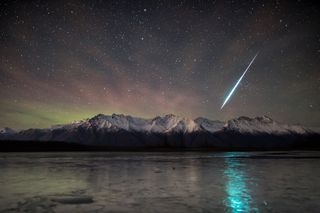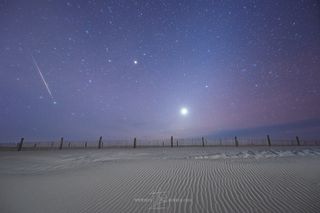So far, 2019 has been a disaster if you are an enthusiastic watcher of "shooting stars."
That's because many of the principal meteor showers have been severely hindered by bright moonlight. Generally speaking, if the moon's phase lies somewhere between first quarter and full or between full phase and last quarter, and is above the horizon when a meteor shower is due to occur, the light of the moon will no doubt outshine all but the brightest streaks.
This year, the April Lyrids, August Perseids, October Orionids, and November Taurids and Leonids have all run up against interference from the moon.
Related: Best Night Sky Events of December 2019 (Stargazing Maps)
And now, to add insult to injury, the final and worst scenario occurs this weekend, when the very best and the most reliable of the annual meteor displays will fall just two days after a full moon. The Geminid meteors are scheduled to reach their peak during the overnight hours of Friday (Dec. 13), into the predawn hours of Saturday (Dec. 14).
The moon will also be in the sky all through these hours. It will be 95% illuminated, shining at a dazzling magnitude of -12, more than 600 times brighter than Venus, appearing like a spotlight and shining smack-dab in the middle of the constellation Gemini, from which the meteors appear to radiate (hence their name, "Geminids"). The brilliant moonlight will likely hide all but the brightest meteors.
Bummer!

Graceful, colorful and spectacular — maybe
The Geminids are often described as "bright and intensely colored," and are typically plentiful, with as many as 120 meteors per hour for a single observer in the absence of moonlight, something that is all but out of reach this year.
And we can offer a solution to the moon problem — call it "damage control" — for the 2019 Geminids.
On Saturday evening, the moon will not rise until shortly after 7 p.m. local time. The radiant of the Geminid meteors (situated near the bright star Castor) will come above the northeast horizon just as evening twilight is ending, around 6 p.m.
That short window of dark skies — from about 6 to 7 p.m. — will probably offer you the best chance this year of seeing a few bright Geminids flitting across the sky. Early Saturday evening, there is a fair chance of catching sight of some "Earth-grazing" meteors: long, bright shooting stars that streak overhead from a point near or just below the horizon.
Such meteors are so distinctive because they follow very long paths nearly parallel to our atmosphere. In this year's Geminids, look for meteors racing almost straight up from the northeast horizon to a point ending overhead.

2020 will be a gem for the Geminids
As bad as the viewing circumstances are for this year's Geminids, next year will be quite a different story. The shower's peak is expected during the evening hours of Dec. 14. Typically, the peak should last for about 10 hours centered on 9 p.m. EST.
That means that skywatchers in eastern North America will be in excellent position to view the Geminids at their prospective 120 meteors per hour maximum when Gemini is situated overhead at 2 a.m. And if you're wondering about the moon, it will be new, with no moonlight in the sky. In short, perfect viewing conditions!
I, for one, can hardly wait.
Joe Rao serves as an instructor and guest lecturer at New York's Hayden Planetarium. He writes about astronomy for Natural History magazine, the Farmers' Almanac and other publications. Follow us on Twitter @Spacedotcom and on Facebook.

"how" - Google News
December 13, 2019 at 05:51AM
https://ift.tt/2rIwE0V
How to See Friday Night's Geminid Meteor Shower, Despite the Moonshine - Space.com
"how" - Google News
https://ift.tt/2MfXd3I
Bagikan Berita Ini














0 Response to "How to See Friday Night's Geminid Meteor Shower, Despite the Moonshine - Space.com"
Post a Comment